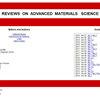Optimization and characterization of composite modified asphalt with pyrolytic carbon black and chicken feather fiber
IF 3.6
4区 材料科学
Q2 MATERIALS SCIENCE, MULTIDISCIPLINARY
引用次数: 0
Abstract
Asphalt is a vital construction material for roads, and its properties can be enhanced by modification. In this study, a composite modified asphalt was developed using pyrolytic carbon black (PCB) and chicken feather fiber (CFF). Box–Behnken design of response surface methodology was employed to optimize the preparation parameters, and the optimal parameters were determined to be a PCB dosage of 15% (weight ratio), a CFF dosage of 0.3% (weight ratio), and a chicken feather (CF) shear time of 8.2 min. A Dynamic Shear Rheometer (MCR302) was used to analyze the high-temperature rheological properties of the modified asphalt samples, and the results showed that the addition of PCB and CFF enhanced the high temperature performance and anti-aging performance of the asphalt. The rheological properties at high temperature increased progressively with the increase in CFF dosage. The Bending Beam Rheometer (BBR) test was conducted to evaluate the low-temperature rheological property of PCB/CFF composite modified asphalt, which was observed to decrease with the increase in CFF dosage. The microscopic properties and the chemical group of 15% PCB + 0.3% CFF with 8.2 min CF shear time composite modified asphalt (0.3%PC-MA) were analyzed using Fourier Transform Infrared spectrometer and Fluorescence Microscopy, and the results indicated that PCB and CFF were physically blended with asphalt without undergoing a chemical reaction, and they were well compatible with and evenly distributed in asphalt. Finally, the high- and low-temperature performances, as well as water stability, of the base asphalt (BA), 15% PCB dosage modified asphalt (P-MA), and 15% PCB dosage modified asphalt with热解炭黑与鸡毛纤维复合改性沥青的优化与表征
沥青是一种重要的道路建筑材料,它的性能可以通过改性来提高。以热解炭黑(PCB)和鸡毛纤维(CFF)为原料,研制了一种复合改性沥青。采用响应面法的Box-Behnken设计对制备参数进行优化,确定最佳制备参数为PCB用量15%(重量比)、CFF用量0.3%(重量比)、鸡毛剪切时间8.2 min。采用动态剪切流变仪(MCR302)对改性沥青样品的高温流变特性进行分析。结果表明,PCB和CFF的加入提高了沥青的高温性能和抗老化性能。随着CFF用量的增加,材料的高温流变性能逐渐提高。通过弯曲梁流变仪(BBR)试验对PCB/CFF复合改性沥青的低温流变性能进行了评价,发现CFF掺量越大,PCB/CFF复合改性沥青的低温流变性能越低。利用傅里叶变换红外光谱仪和荧光显微镜对15% PCB + 0.3% CFF、CF剪切时间为8.2 min的复合改性沥青(0.3% pc - ma)的微观性质和化学基团进行了分析,结果表明PCB和CFF与沥青物理共混,未发生化学反应,且与沥青具有良好的相容性和均匀分布。最后,比较了基础沥青(BA)、15% PCB掺量改性沥青(P-MA)和15% PCB掺量加x% CFF剪切时间为8.2 min的改性沥青(PC-MA)的高低温性能和水稳定性。CFF的加入显著提高了P-MA混合物的高温、低温性能和水稳定性。本研究旨在为PCB/CFF复合改性沥青的应用提供实验室试验依据。
本文章由计算机程序翻译,如有差异,请以英文原文为准。
求助全文
约1分钟内获得全文
求助全文
来源期刊

Reviews on Advanced Materials Science
工程技术-材料科学:综合
CiteScore
5.10
自引率
11.10%
发文量
43
审稿时长
3.5 months
期刊介绍:
Reviews on Advanced Materials Science is a fully peer-reviewed, open access, electronic journal that publishes significant, original and relevant works in the area of theoretical and experimental studies of advanced materials. The journal provides the readers with free, instant, and permanent access to all content worldwide; and the authors with extensive promotion of published articles, long-time preservation, language-correction services, no space constraints and immediate publication.
Reviews on Advanced Materials Science is listed inter alia by Clarivate Analytics (formerly Thomson Reuters) - Current Contents/Physical, Chemical, and Earth Sciences (CC/PC&ES), JCR and SCIE. Our standard policy requires each paper to be reviewed by at least two Referees and the peer-review process is single-blind.
 求助内容:
求助内容: 应助结果提醒方式:
应助结果提醒方式:


